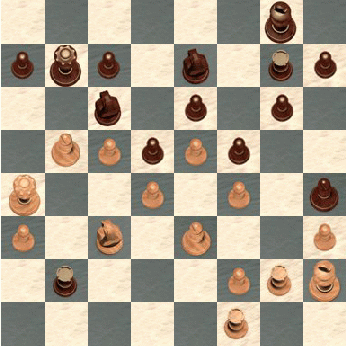1. e4,
Fantastic! I just drew with a 2324, and here's a fat 2375, playing white, and
mad for having lost half a point himself in his first game. I decided that
I would play the defence I know best, even if it is slightly passive.
1...., Nf6;
2. e5, Nd5;
3. d4, d6;
4. Nf3, Bg4;
5. Be2, e6;
6. 0-0, Be7;
7. h3,
Wow, the IM knows it all! Just kidding... As a matter of fact, before the
game I had looked at my database and had found six Alechin defences
played with white by Klundt. He seemed to like the four pawns attack, which
I like to play as black... Unfortunately he decided on the modern variation
this time, throwing away my prepared variations...
7...., Bh5;
8. c4, Nb6;
9. Nc3, 0-0;
10. Be3, d5;
11. c5, Bxf3;
12. gxf3, Nc8;
13. f4, Nc6;
14. b4,
Alas, he does not play 14.f5, which is where I have something in store...
14...., Bh4N;
This move must have been played before, but is unknown to my database. The
game J.Benjamin-B.Men (US Ch. 1992) went on 14....a6; 15.a3,Bh4; 16.Bd3,N8e7;
17.Qg4,Ng6; 18.Kh2,f5; 19.Qh5,Be7; 20.Rg1,Qe8 and Joel eventually won after
29 more moves.
More interesting is to know what happens if black takes the b4 pawn: it took
me a while to recall over the board why it is better not to.
If 14....Nxb4 white can play:
(A) 15.Qb1,a5; 16.a3,Nc6; 17.Qxb7 (17.Bd3,f5; 18.exf6,Bxf6; 19.Bxh7+,Kh8;
20.Qg6,Qe8; 21.Nb5,Qxg6; 22.Bxg6,N8e7; 23.Bc2,Rac8 with a better game for
black), N8a7; 18.Rfb1,Qd7; 19.Qa6 (19.Nb5,Rfc8; 20.Qa6,Nxb5; 21.Qxb5,Rcb8;
22.Qd3 looks drawish), Rfb8 with even chances; but better for white is:
(B) 15.Rb1,a5; 16.a3,Nc6; 17.Rxb7,Rb8; 18.Rxb8,Nxb8; 19.f5!, and white has
play on both wings and retains the initiative.
15. Kh2,
Correctly, the IM does not accept my invitation to play b5. After 15.b5,N6e7;
16.Bd3,Nf5; 17.Bxf5,exf5; 18.Qf3,c6; 19.bxc6,bxc6; 20.Rfb1,a6; 21.Rb7,Re8;
22.Rab1,g6; 23.Bd2,Re7; 24.R7b2 black has equal chances.
18. Qb3, Nbc6;
19. Rag1, Rf7?!;
Not intrinsically a bad move, but certainly less good than the spontaneous
19....,g6. I saw g6, but started to fear ghosts of instant attacks involving
Bh5, Qd1, sacrifices on g6 and mate. After 19....,g6 actually white does not
have anything better than 20.Qxb7,Rb8; 21.Qa6 with equality, but black
does have to look at the following variation, and see how to defend, before
playing his 19th:
19....,g6; 20.Bh5?!,b6! (20....,Na5;21.Qd1,b6 -but 21....,Rf7 is still a good
defence-; 22.Bxg6,Nxg6;23.Rxg6+,hxg6;
24.Rxg6,Kf7;25.Qh5 and white indeed wins); 21.Qd1,Kh8!(21....,bxc5
loses by the same attack shown in the former variation); and this time
the sacrifices in g6 lose for white.
20. Qxb7, Rb8;
21. Qa6, Qc8;
22. Qa4, Rb4;
23. Qd1, g6;
Probably better would have been 23....,Ng6, eliminating once and for all the
weakness of the Bh4 (threatened to fall prey of a Qh5), with the possible
followup 24.Bb5,Na5; 25.Qh5,Be7 and black is OK.
24. Bb5, Rg7;
25. a3, Rb2;
26. Qa4!,
IM Klundt makes a good display in this game of how to play when the only
tangible advantage you have is space. He creates threats on both sides of
the board, quickly moving from one side to the other, trying to overload
his opponent's pieces. Nevertheless, the position is still balanced, and
black still has good prospects if the initiative slips in his hands. But
white is trying to create a mating net around the black rook, and good care
has to be taken...
26...., Qb7;
27. Rf1,

27...., Kh8?;
Probably the losing move, although there is still lots to fight for. With
his last move Klundt prepared Bc1, and I completely overlooked it (yeah,
yeah, I was short of time, but I should have seen it). What bothers me is
that I HAD seen the strongest move here, and got afraid to play it! A
deep pawn sacrifice here was necessary:
27....,a6!!;
(A) 28.Bxa6,Qb3; and now:
(A1) 29.Qxb3,Rxb3;30.Nb1,g5! 31.Rfg1,Ng6; 32.Bc8,Kf7; 33.Bd7,gxf4;
34.Bxc6,fxe3; 35.fxe3,Rxe3;36.a4,h6;37.Rxg6,Rxg6 and the ending should be
won for black after 38.Be8+,Kxe8; 39.Rxg6,Bg5.
(A2) 29.Rc1,Qxa4;30.Nxa4,Ra2;31.Rc3,Kf7!;32.Bd3,h6;33.Rb3,Na5;34.Rc3,g5;
35.Bb1,Ra1;36.Bd3,gxf4;37.Bxf4,Ra2 with advantage for black.
(B) 28.Qxa6,Qxa6; 29.Bxa6,Rb3;30.Nb1,g5; with two main options:
(B1) 31.Rfg1,Ng6;32.Bc8,Re7;33.Nd2,Rxa3;34.Nf3,Nd8;35.Nxg5,Bxg5;36.Rxg5,Ra8;
37.h4,Rxc8;38.h5,Rg7;39.hxg6,Rxg6;40.Rxg6+,hxg6;41.Rxg6+,Kf7;42.Rg1,Nc6 where
white is a pawn up but the ending can only be won by black.
(B2) 31.fxg5,f4; 32.Bxf4,Nxd4;33.Nd2,Rxa3;34.Bb7,Ndf5;35.Rg4,Kh8;36.Be3,Ng6;
37.Nf3,Bxf2;38.Rxf2,Rxe3;39.Bc8,Rxf3;40.Rxf3,Nxe5;41.Rff4,Nxg4+;42.hxg4,Ne3;
43.Rf8+,Rg8;44.Rxg8+,Kxg8;45.Bxe6+,Kg7;46.Kg3,Kg6;47.Kf3,d4 with a draw.
While all these complex variations should not be taken as definitive truth
about the position, they give the flavor of the many possibilities that the
27th black move could open. I cut many branches of my analysis for brevity;
the interested reader may well
ask for them.
28.Bc1, Nxd4;
Forced, since 28....,Rxb5;29.Qxb5,Qxb5;30.Nxb5,Nc8;31.Be3,a6;32.Nc3,g5;33.Rb1
is an easy win for white.
29.Bxb2, Nf3+;
30.Kh1, c6;
31.Qd1, d4!;
32.Be2,
Better for white would have turned out to be 32.Bc4,Qxb2;33.Nb1,Nd5;
34.Qxf3,Rd7;35.Rfg1, but Klaus correctly thinks that I'm going to resign
anyways...
32...., Qxb2;
Better than 32....,dxc3; 33.Bxc3,Nd5; 34.Ba1,Nxf4; 35.Bxf3,Nxg2;36.Bxg2, where
white's material advantage is easier to convert in a win due to the simpler
position.
33.Na4, Qxa3;
34.Bxf3, resigns?
Actually, resigning here is the worst move of my game. True, playing on a
rook down against an International Master looked very humiliating; nevertheless,
white still has lots of homework before he can find the way to a win here.
I analyzed thoroughly this position with days of CPUtime of Fritz 5 running
on my pentium 133, and came to the conclusion that the game is still not decided. Skeptics ? Let's look at some variations.
34....,Rg8!;
(A) 35.Be2,d3; 36.Bf3,Rd8; 37.Qa1,Qb4;38.Nb2,d2; and now:
(A1) 39.Be2,Nd5;40.Nd3,Qc4;41.Rd1,Nc3;42.Rxd2,Nxe2;43.Nb2,Qb5!;44.Qd1,Rxd2;
45.Qxd2,a5;46.Qd6,Kg7;47.Qd7+,Kh6;48.Nd3, and black has compensation for
the material.
(A2) 39.Qa2,Qxf4;40.Qc4,Bg5;41.Be2,Nd5;42.Qxf4,Bxf4; with an unclear game
(I know, white has a rook for three pawns and this should suffice... The fact
is that Fritz insists on saying that it is a balanced position! Now if he does
not care for the material, why should I ? HE is the computer...).
(B) 35.Rg3,Rd8;36.Qa1,Qb4;37.Bg2,Bxg3;38.fxg3,d3;39.Rb1,Qa5; with two
variations:
(B1) 40.Bf1,d2;41.Bg2,Nd5;42.Bxd5,Rxd5;43.Kh2,Rd8; with unclear play.
(B2) 40.Qa2,d2;41.Qb3,Qb5!?;42.Qxb5,cxb5;43.Nc3,a6;44.Rd1,Rd3;45.Nb1,Rxg3;
with a better game for white, although not yet decided.
Go back to TD's Chess Page